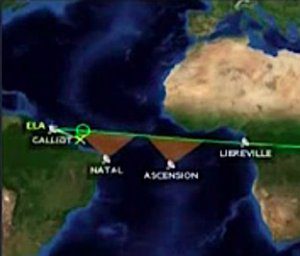The Independent Enquiry Commission chaired by Toni Tolker-Nielsen, ESA Inspector General, has reported the results of its analysis of the Ariane 5 launcher’s trajectory deviation during Flight VA241 flight on 25 January 2018. The faulty launch left SES-14 and Al Yah 3 in a transfer orbit with a dramatically increased inclination of 20.6 degrees, compared with the expected 3 degrees. The apogee and perigee were close to the targeted 45,234 x 249km for the planned super-synchronous orbit.
The analysis found that while the launcher mechanism and the rest of the flight programme operated as planned (including the later “dog leg” manoeuvre by the upper stage to make a small reduction to inclination), an incorrect value set in the system led to the wrong azimuth value being aimed for by the vehicle’s two Inertial reference systems at launch.
The launch azimuth is the angle between north direction and the projection of the initial orbit plane onto the launch location. In effect, it is the compass heading aimed for after launch.
For this VA241 launch a “special” platform azimuth value for the IMU (Inertial Measurement Unit) alignment should have been set at 70 degrees, but was instead mistakenly set to 90 degrees – the more normal setting. The inertial reference system was aligned at the usual and planned 90 degrees azimuth, however a correction of 20 degrees to the target azimuth had to be set so that the rocket thought it was heading to 70 degrees as it flew at 90. This software change was requested because one of the satellites carried, the Al Yah 3 (this is corrected from previously written SES-14), had to be released at a right angle relative to the direction of motion of the rocket (i.e. its velocity vector). This correction was needed to prevent one of the rocket’s gyros going past its null position as this delivery happened.
However, the failure to make the 20 degree azimuth setting change correctly led to the Ariane 5 ECA rocket actually flying with a 20-degree shift southwards to an launch azimuth of 110 degrees in a south easterly direction.

The faulty ground track (shown yellow) was initially faithfully shown on the CNES display of the launch. It is veering further south of its planned South Easterly track (green). Courtesy: CNES
Due to the rarity of such an IMU alignment setting change, the targeting fault was not detected by the standard quality checks carried out during the Ariane 5 preparation. The result was that the launch was sent in a South Easterly direction rather than in the planned Easterly one.
The Independent Enquiry Commission’s work has recommended more robust control of data used in preparation for future missions. Arianespace and ArianeGroup immediately implemented the recommendations and expect Ariane fights to resume in March.
Despite the satisfactory results of the enquiry, local concern remains that the rocket passed close to the town of Kourou with no attempt being made to destroy it for range safety reasons. Meanwhile, the deviation in the trajectory meant that later in the flight telemetry was lost as tracking radars and telemetry receivers at Natal and Ascension Island were pointing in the wrong direction. For most of the flight no-one had any idea where the rocket was until signals were received indicating that the two satellites had reached orbit.






